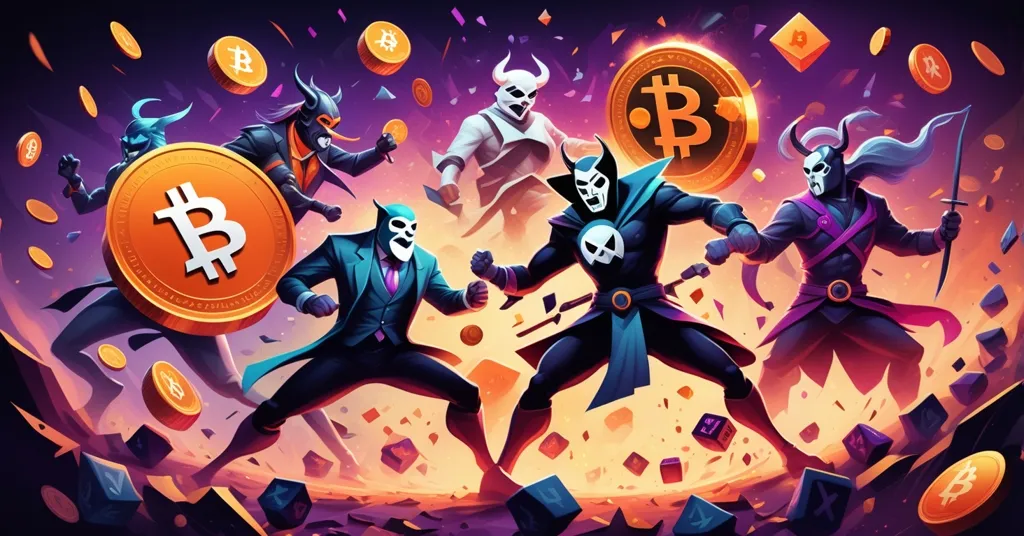XRP, Monero, and MoonBull Clash for Crypto Dominance in October 2025 Presale Hype

XRP and XMR Battle for October 2025 Dominance as MoonBull Hypes Presale Mania
With Bitcoin tripping over its own feet in October 2025, casting doubts on that lofty $150K year-end dream, the altcoin battlefield is buzzing with action. Ripple (XRP), Monero (XMR), and the freshly minted presale token MoonBull ($MOBU) are stealing attention for wildly different reasons, each representing a unique slice of the crypto chaos—utility, privacy, and raw speculation.
- XRP sticks to a $0.52 support, with whispers of a $4 surge if momentum holds.
- XMR shines as a privacy titan at $122.40, fueled by growing trading volume.
- MoonBull ($MOBU) dangles an 11,800% ROI carrot in its presale, screaming “next big thing” for 2025.
XRP at $0.52: Legal Quagmires and a $4 Fantasy
Ripple’s native token, XRP, remains a lightning rod in the crypto sphere, trading at a precarious $0.52 as of October 2025. For the unacquainted, XRP powers Ripple Labs’ mission to overhaul cross-border payments with near-instant, dirt-cheap transactions through blockchain tech. It’s a darling for institutional players looking to streamline global money flows, but it’s also been stuck in a legal cage match with the U.S. Securities and Exchange Commission (SEC) for years. The core issue? Whether XRP qualifies as a security—essentially, a stock-like asset under strict regulatory oversight—that could hamstring its adoption if the SEC wins.
Market watchers are cautiously hopeful, pointing to a potential rally to $4 if XRP holds above its $0.50 support through this month. This isn’t just pie-in-the-sky thinking; XRP has a track record of resilience during market downturns, often buoyed by real-world partnerships with banks and payment processors. A hypothetical settlement or favorable ruling in the SEC case by late 2025 could act as a catalyst, alongside technical chart patterns showing bullish breakouts. Yet, let’s not sip the Kool-Aid just yet. Regulatory clarity is a double-edged sword—while a win could unleash adoption, a loss might slap XRP with rules that choke its utility. Plus, some in the crypto community grumble that Ripple’s centralized control (holding a massive chunk of XRP supply) makes it Bitcoin’s less rebellious, suit-wearing cousin. Does it even align with decentralization’s ethos, or is it just swapping one middleman for another?
As Q4 looms, XRP’s fate hinges on courtrooms as much as code. Recent murmurs of expanded partnerships with fintech giants in 2025 could bolster its case, but the shadow of legal uncertainty keeps investors on edge. If you’re betting on XRP, keep one eye on price charts and the other on legal headlines—it’s a high-stakes gamble with no guaranteed payoff.
Monero: Privacy as a Middle Finger to Surveillance
Monero (XMR) is holding court as the heavyweight of privacy coins, priced at $122.40 with a tidy 4.78% bump in 24 hours this October. For newcomers, privacy coins are a breed apart, using sophisticated cryptography to hide transaction details—sender, receiver, and amount—unlike Bitcoin’s public ledger where every move is traceable. With a market cap of $2.22 billion and daily trading volume topping $53 million, XMR is carving out serious territory for those who value financial anonymity in a world obsessed with tracking every digital footprint.
What’s fueling this rise? Monero’s relentless focus on untraceable transactions via features like ring signatures and stealth addresses keeps it ahead of the pack. Hypothetical network upgrades in 2025, such as tighter transaction obfuscation or faster processing, only sweeten the deal. Its mining algorithm, designed to resist specialized hardware, also supports a more decentralized network compared to Bitcoin’s ASIC-dominated landscape. As governments ramp up KYC (Know Your Customer) rules and surveillance, XMR’s appeal skyrockets for users craving sovereignty over their funds. Compared to rivals like Zcash, which offers optional privacy, Monero’s mandatory anonymity makes it the purist’s choice.
But don’t pop the champagne just yet. Privacy is a magnet for regulatory heat—XMR has been booted from exchanges in jurisdictions like Japan and South Korea in the past due to fears of illicit use. A full-on ban in major markets isn’t a far-fetched nightmare, especially as 2025 sees tighter global crypto laws. While its community and developers are fiercely committed, the risk of accessibility issues looms large. Monero’s strength is its defiance of overreach, but that same defiance could paint a target on its back. If you’re eyeing XMR, weigh the thrill of financial freedom against the reality of regulatory whack-a-mole.
MoonBull: Presale Promises or Potential Scam Territory?
Tokenomics and Tempting Numbers
Enter MoonBull ($MOBU), the shiny new toy in the crypto sandbox, currently in Stage 4 of its presale at a bargain-basement $0.00005168 per token. Pegged for a listing price of $0.00616, it’s waving a staggering potential return of over 11,800% at early investors. To break it down, tokenomics—basically the economic blueprint of a cryptocurrency—include 2% of each transaction funneled into liquidity pools (funds to ease trading and stabilize price), 2% redistributed to holders as passive income, and 1% burned to shrink supply and, in theory, boost value. From Stage 10, a staking model offers a fixed 95% APY (Annual Percentage Yield), a juicy reward for locking up tokens, with 14.6 billion $MOBU earmarked for this. A referral bonus of 15% for both parties sweetens the pot. With over $300K raised and 1,000+ holders already, the buzz is loud.
Risks of Presale Hype
Before you mortgage your house for $MOBU, let’s slam on the brakes. Presale tokens are the Wild West of crypto—full of dazzling promises but often littered with scams and rug pulls (when developers vanish with investor funds). That 95% APY and massive ROI projection? They scream unsustainable. High yields often collapse under their own weight, draining value faster than a popped balloon. Token burns sound sexy, but if demand doesn’t match, they’re just smoke and mirrors. And let’s be real: the sponsored buzz around MoonBull smells like FOMO bait, not a revolution. No proven track record, no audited smart contracts, anonymous teams—these are red flags that could signal disaster. If this feels like a blockchain-wrapped lottery ticket, you’re not far off. Dig into whitepapers and team credentials before even thinking of diving in. We champion innovation, but this kind of hype often distracts from Bitcoin’s core mission as sound, decentralized money.
Bitcoin’s Stumble: A Window for Altcoin Action?
Looming over this altcoin circus is Bitcoin, which has hit a rocky patch in October 2025. A price pullback—possibly driven by macroeconomic headwinds like rising interest rates or profit-taking after a prior rally—has dimmed hopes of hitting $150K by year’s end. Historically, when BTC consolidates or corrects, capital often trickles into altcoins, sparking what enthusiasts call “altseason,” a period where alternative cryptocurrencies steal the spotlight. Data from past cycles, like 2017 and 2021, shows altcoin market caps swelling during Bitcoin’s pauses, as investors chase higher-risk, higher-reward plays.
This dynamic could be a boon for XRP, XMR, and even speculative bets like MoonBull, as restless money seeks new homes. Yet, Bitcoin’s wobble also signals broader market fragility—sentiment can sour fast if macroeconomic pressures intensify. While we root for decentralization’s spread across diverse projects, BTC remains the bedrock. Its struggles remind us that no coin, no matter how hyped, is immune to external shocks. Keep tabs on global financial trends as much as blockchain updates; they’re often the invisible hand steering crypto’s fate.
The Bigger Picture: Utility, Privacy, or Speculation?
Zooming out, XRP, Monero, and MoonBull embody three pillars of the crypto landscape: utility, privacy, and raw speculation. XRP’s push for institutional-grade payment systems, despite its centralized leanings, offers a tangible use case that could bridge traditional finance and blockchain—if it survives the legal gauntlet. Monero stands as a beacon of individual freedom, prioritizing untraceable transactions over regulatory compliance, a stance that’s both its superpower and Achilles’ heel. MoonBull, meanwhile, represents the gambler’s itch—presale tokens promising astronomical gains often fuel early adoption but rarely sustain long-term value.
As advocates of effective accelerationism and disrupting the status quo, we’re thrilled by the chaos these projects unleash on outdated financial systems. XRP challenges sluggish banking norms, XMR spits in the face of surveillance overreach, and even MoonBull’s audacity, if legit, could democratize wealth for early risk-takers. But let’s not kid ourselves—each path is fraught with landmines. Regulatory crackdowns, market manipulation, and outright scams are the dark underbelly of this revolution. Bitcoin maximalists might argue altcoins dilute the mission of sound money, but we see value in niche innovation, provided it’s not just smoke and mirrors. The trick is discerning signal from noise, utility from hype.
Key Questions and Takeaways for Crypto Enthusiasts
- Can XRP realistically climb to $4 in Q4 2025?
It’s within reach if it holds above $0.50 and legal wins or partnerships spark momentum, but an SEC ruling labeling it a security could crush that dream overnight. - Is Monero (XMR) a solid bet for privacy seekers in 2025?
Its tech and market cap of $2.22 billion make a strong case, but regulatory bans in key markets could limit access, posing a significant risk. - Should you dive into MoonBull ($MOBU) during presale?
The projected 11,800% return and 95% APY are seductive, but unproven projects like this scream scam potential—proceed only with ironclad due diligence. - Does Bitcoin’s pullback open doors for altcoins?
Yes, historically, BTC corrections fuel altcoin rallies as capital shifts, but market-wide fragility means gains aren’t guaranteed in 2025. - Does XRP’s institutional focus undermine decentralization?
Arguably, yes—Ripple’s control and corporate partnerships clash with crypto’s rebel spirit, raising questions about its alignment with Bitcoin’s vision. - Are presale tokens like MoonBull a distraction from crypto’s mission?
Often, they are—hype-driven gambles can overshadow fundamentals like sound money and privacy, though genuine outliers could still spark innovation if they survive.
Navigating this crypto jungle demands sharp wits and thicker skin. Flashy numbers and overnight-riches tales are tempting, but they’re often the siren song of rug pulls and heartbreak. XRP and Monero offer grounded, if risky, plays with real utility, while MoonBull is a roll of the dice best left to the reckless or the rigorously informed. As we push for decentralized tech to upend the old guard, let’s champion the disruptors but call out the charlatans. Your best weapon is skepticism—dig into code, track legal battles, and never wager what you can’t afford to lose. The financial revolution is a grind, not a get-rich-quick scheme, and only the savvy will ride the wave.



